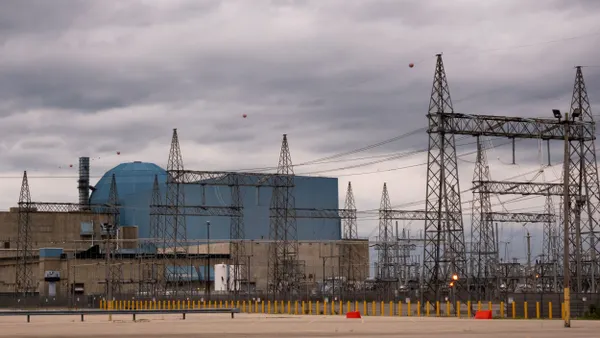Dive Brief:
- Utility sector stocks were hit hard last week, with the Utilities Select Sector SPDR Fund (XLU) dropping approximately 17% amid broader market declines related to the spread of COVID-19 and its economic impacts.
- While the S&P 500 and Dow Jones Industrial Average began falling about a month ago and at one point had shed roughly 30% of their value, utility stocks maintained their value longer before beginning to fall in earnest in early March.
- Utilities are typically seen as a "defensive" sector and tend to hold their value in downturns, according to Ian Bezek, an associate analyst for Value Investor's Edge. But once the full extent of the novel coronavirus became apparent, share prices of electric companies began to plummet. Observers are mixed on their outlook for a potential recovery.
Dive Insight:
Experts say utility customers are unlikely to see any impact from falling share prices, but rather there are operational and regulatory issues now impacting the stock values.
"There will be pressure on overall electricity demand, particularly if lockdowns run for more than two weeks," Bezek told Utility Dive in an email. "Government orders to delay collecting on past-due bills could hurt cash flow, and potentially lead to dividend freezes or cuts."
Bezek also warned that lower interest rates and a potential recession could lead regulators to reduce utilities' return on equity (ROE) going forward.
"Utility stocks held up much longer than the overall market," Bezek said. "Over the past week or two, it's become clear that this is a full-blown recession/bear market, not just a correction. Investors have responded by selling even their safest assets, such as utilities, food and beverage stocks, and gold in order to get much-needed cash."
The difference between S&P 500 and Dow Jones Industrial Average drops and the utility sector's decline "was investors holding hope beyond hope their [dividend] income and yield level would give their share prices some support," according to George Fisher, founder of Guiding Mast Investments. "That obviously didn't happen."
And with interest rates slashed by the Federal Reserve "it may be difficult for utilities to recapture their higher ROE when when the tide turns," said Fisher. "That's where regulatory lag will especially hurt utilities."
S&P Global Ratings, in a March 19 report, said the majority of North American regulated utilities "are well positioned to handle the immediate impact of COVID-19." But some electric utilities with "disproportionate" exposure to commercial and industrial demand could be vulnerable to reduced sales volumes.
"The pandemic could negatively affect a few outliers and those issuers already facing downside ratings pressure prior to the arrival of the coronavirus," S&P said. Large-scale projects could face delays, and if the pandemic impacts are lengthy it "may constrain some utilities' ability to execute on planned equity issuance or weaken access to the capital markets."
While S&P expects an annualized contraction of about 6% in the U.S. economy in the second quarter, the firm is also anticipating a second-half recovery.
Bezek noted that some utility stocks are faring better than others. Utilities with credit ratings of A- or better at S&P are significantly outperforming those at BBB+ or lower, he said.
"Many of the biggest losers, such as DTE Energy, MDU Resources, OGE Energy, and CenterPoint are all among the lower-rated firms," Bezek said. "In bear markets, investors tend to buy companies with stronger balance sheets, and shun those that are weaker."
Markets rallied broadly Tuesday on hopes for a coronavirus stimulus, which the U.S. Senate delivered early Wednesday morning, reaching agreement on a $2 trillion package.
DTE was down about 40% in the last month, before yesterday's rally. MDU had fallen by 50% at one point last week. OGE is off about 40% from month-ago levels. CenterPoint is down about 40% now, but had also been down as much as 50%.
Bezek said CenterPoint in particular is struggling because it owns a large stake in Enable Midstream Partners, whose stock price has fallen from $14 to $2 over the last year. "Any utility that has additional complexity, such as CenterPoint with its pipeline business causes further investor nervousness," he said.
On CenterPoint, Fisher said investors fear "that a decrease in profitability of the midstream sector will affect the utility. Because of that, regulators have been cutting the ROE for CenterPoint, creating some financial stress."
Bezek suggests there "could be a swift recovery for utility stocks," once investors sense losses have bottomed out and begin moving back into traditionally safe stocks with strong dividends.
"I expect many people to buy utility shares as they currently offer their highest dividend yields in years," Bezek said. "I expect large utilities with strong credit ratings such as Consolidated Edison and Xcel Energy to find a bottom and start recovering the fastest."
Consolidated Edison had maintained its value through the market rout, but on Monday closed around $65/share down from around $90 in the prior week. Xcel Energy hit $50/share on Monday, down from $70 in early March.
Fisher pointed to a utility's regulatory environment as the key to its stock price recovery. In particular, he noted the Southeast is favorable and expects Southern Company, NextEra Energy, Dominion Energy and Duke, to fare well in recovery.
Southern is off its March highs by more than 25%. NextEra traded around $280/share in early March, but was down to around $180/share on Monday. Dominion had shed 30% of its share price before yesterday's rally. Duke is down about 30% relative to March highs.
"Companies operating in states with better regulatory environments ... are really the stocks that are the cream of the crop," said Fisher.














